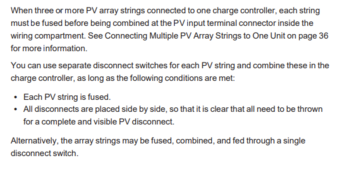Solar User
New Member
Hello to all,
I am a relative beginner to the solar world and I am in the process of setting up my first basic station. I am working on a diagram to help with what I need but I am a little confused about inline MC4 fuses and their purpose. I assumed that you would put a fuse inline right after the panel that would be the rating of the wire that you had running from the panel to the charge controller but when I look at the ads for the inline fuses, they state that they are used to protect the panels. As an example, if I have a 100 watt panel connecting to a run of 10AWG wire (30 amp rating), wouldn't I want to put a 30 amp inline MC4 fuse where the panel hooks to the run of 10 AWG wire (in order to not exceed the 30 amp rating of the wire)? Is there a way for power to run to the solar panel from the charge controller instead of from the solar panel? Thanks for any clarification on this.
By the way, in case it helps, I am trying to install a solar charge controller (thinking Victron 150/45) inline to 12.8V Power Queen Batteries. So far, I am thinking that I will be running 10AWG PV wire from a solar panel (or series of solar panels) to a 40A switch (https://www.amazon.com/dp/B09BQP924...788459f3&language=en_US&ref_=as_li_ss_tl&th=1) and then more 10AWG PV wire to the Victron. 10AWG from the Victron to the battery or batteries in series (probably with a 30amp fuse inline between the controller and battery on the positive side). Please let me know if anybody sees any issues with this setup.
I am a relative beginner to the solar world and I am in the process of setting up my first basic station. I am working on a diagram to help with what I need but I am a little confused about inline MC4 fuses and their purpose. I assumed that you would put a fuse inline right after the panel that would be the rating of the wire that you had running from the panel to the charge controller but when I look at the ads for the inline fuses, they state that they are used to protect the panels. As an example, if I have a 100 watt panel connecting to a run of 10AWG wire (30 amp rating), wouldn't I want to put a 30 amp inline MC4 fuse where the panel hooks to the run of 10 AWG wire (in order to not exceed the 30 amp rating of the wire)? Is there a way for power to run to the solar panel from the charge controller instead of from the solar panel? Thanks for any clarification on this.
By the way, in case it helps, I am trying to install a solar charge controller (thinking Victron 150/45) inline to 12.8V Power Queen Batteries. So far, I am thinking that I will be running 10AWG PV wire from a solar panel (or series of solar panels) to a 40A switch (https://www.amazon.com/dp/B09BQP924...788459f3&language=en_US&ref_=as_li_ss_tl&th=1) and then more 10AWG PV wire to the Victron. 10AWG from the Victron to the battery or batteries in series (probably with a 30amp fuse inline between the controller and battery on the positive side). Please let me know if anybody sees any issues with this setup.



